“Truth is so rare, it is delightful to tell it.” ~ Emily Dickinson
I’ve been curious about Emily Dickinson’s relationship with children ever since learning that she used to lower baskets of gingerbread to the neighborhood kids.
 That’s why I loved Burleigh Mutén’s delightful verse novel Miss Emily (Candlewick, 2014). It gave me a good sense of how Dickinson might have interacted with four of the children in her life: her niece and nephew Mattie and Ned (who lived next door at the Evergreens), and the pastor’s kids Mac and Sally, who lived across the street.
That’s why I loved Burleigh Mutén’s delightful verse novel Miss Emily (Candlewick, 2014). It gave me a good sense of how Dickinson might have interacted with four of the children in her life: her niece and nephew Mattie and Ned (who lived next door at the Evergreens), and the pastor’s kids Mac and Sally, who lived across the street.
This fun and suspenseful adventure, where Emily and the children disguise themselves as gypsies to catch a glimpse of the midnight circus train, is told from Mac’s point of view. It is clear the kids all adore Miss Emily and she, them, united as they are in imaginative play and a singular brand of friendship.
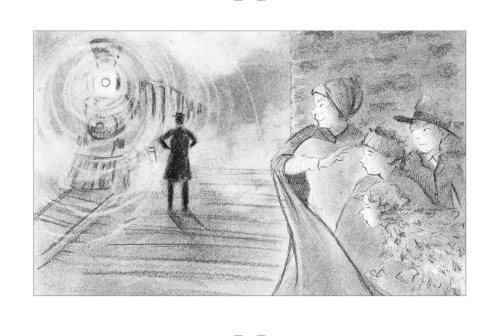
I’m so pleased Burleigh is here today to tell us more about writing and researching Miss Emily. I daresay “the children’s laughing goddess of plenty” herself would be quite pleased with this story, as it celebrates her fondness for children and the importance of remaining true to one’s inner child: therein lies the truth about who we really are and should always strive to be.
Look sharp! The circus train is here. All Aboard! 🙂
* * *

BURLEIGH MUTÉN ON MISS EMILY
Did you grow up liking Emily Dickinson’s poetry? What made you want to write a book about her?
As a child, I was not aware of Emily Dickinson, but I was familiar with her lines, “There is no frigate like a Book/To take us Lands away/Nor any Coursers like a Page/of prancing Poetry.” The slim anthology that my aunt gave me when I was eight was one of my treasures. We did not have many children’s books back then, and the ones I owned were the friends I quietly visited every day.
The simple pen and ink drawing that accompanied that Dickinson poem was of a boy playing with many small figures on his rumpled bedspread. He held the boat aloft in his hand as if it were lifting out of a roiling sea. I remember lingering on all the details of that illustration in particular and memorizing the words.
I began researching Dickinson when I decided to introduce my kindergartners to her. I discovered there were very few books about Dickinson for young children and none that described her as the playful, delightful, and trusted friend of children.
Both MacGregor Jenkins and Emily’s niece Martha have written childhood recollections that reveal another side of the “reclusive Myth in a white dress.” What are your favorite Emily anecdotes from both Mac and Martha?
One of my favorite Emily anecdotes from MacGregor Jenkins’ book, EMILY DICKINSON, FRIEND AND NEIGHBOR (which inspired me to write about her) is his recollection of Miss Emily once remarking in the pantry (as she prepared a snack for the children) that should the butcher arrive unexpectedly, she might have to leap into the flour bin to hide. Her ability to laugh at her reclusiveness was endearing to Mac and to me.
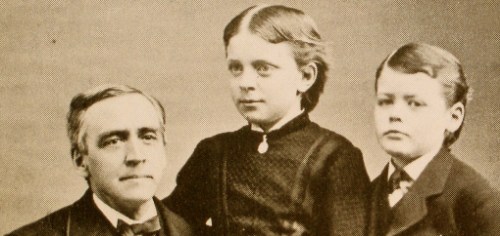
Why do you think Emily continued to enjoy the company of children even while shutting herself away from the rest of the world?
Emily Dickinson had a lot in common with children. A lot of poets do.
I think most young children, new to using language, are poets. And I believe Dickinson did as well. Delight in Nature and in word play are not only common to children, they are part of many poets’ fiber. Children are keen observers, witnesses to the poignant moment, as are poets.
I think Dickinson found her young companions’ honesty and lack of pretension a delight amidst the conventions of polite, prescribed society. I’m sure she enjoyed their ever-ready wit as well. And they, hers.
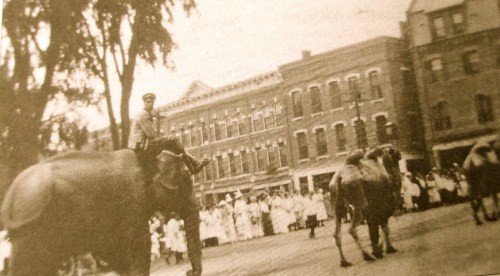
Where did the idea of the circus train come from?
It’s documented in Emily’s letters that she witnessed the circus arriving in town during the middle of the night from her bedroom window. And there is signage in the long, narrow hallway outside the nursery at the Evergreens (the house adjacent to Emily’s where her niece and nephew, Mattie and Ned, grew up) that the children re-enacted the circus train there. As I stood in this hallway when MISS EMILY was a fledgling idea and read the signage, a light bulb lit brightly in the plot-development section of my mind.
Could you please share a few interesting tidbits you learned while researching 19th century circuses? How does the circus that came to Amherst in 1877 compare with circuses we know today?
Researching 19th century circuses was one of the extra pleasures of writing this book. With the help of the curator of our local library’s Special Collections, I was able to find circus advertisements in the local paper. During the early days of the circus, which initially traveled by wagon and eventually by train, most circuses included many horses and trick riders, a few exotic animals like lions and elephants, but mostly horses, bicyclists and acrobats.
Imagine the music of the calliope curling through the air during an era that did not include electronics or much live musical performance! I’m sure the glamorous costumes and exotic animals were an amazement that lasted in the memories of children for a long time afterward.

I enjoyed bringing some real acts from the 19th century back to life in MISS EMILY. The Lion Tamer and Edward the horse’s trainer are based on real characters as is Edward’s rider, a young boy whose stage name was Flying Mercury.
One sad and unfortunate tidbit I discovered while researching was that the first elephant to come to the US was shot and fatally wounded in Maine by a distraught farmer. Since the area was in the midst of a famine, he could not abide by the thought that folks would spend their money to view an animal!

You’ve done a beautiful job of telling this story as a verse novel, yet you first started writing it in prose. Can you tell us a little about the evolution of MISS EMILY from prose to poetry? Overall, what were the most enjoyable and challenging aspects of writing your story in verse?
I started writing free verse as a teenager when I discovered Walt Whitman, but it was not until I read Karen Hesse’s OUT OF THE DUST that I considered writing a verse novel. Writing MISS EMILY freed me to do what I’d wanted to do for decades.
I felt as if Emily insisted that I use my poetic voice. It was time to stop being a personal poet and claim my art in public!

It took me about four years on and off to write the book. Since I work full-time as a kindergarten teacher, I had to write part-time. Once I started writing in verse, however and committed to complete the book during one summer vacation, the writing flowed and I completed the book within a few months. It was very helpful to have family members who were highly interested in my writing process. Those first listeners and readers can be obvious angels, and both my son, Bjorn and grandson, Jonas were just that!
I love lineation, making the decision about where to break the lines so the emphasis falls on a particular phrase or word. Alliteration is another one of my favorite writing devices. Writing poetry is absolute fun for me! Prose is harder for me, but usually turns into prose poetry when I try.

How would you describe the illustrations Matt Phelan did for the book? Do you have a favorite?
Matt Phelan is the perfect illustrator for MISS EMILY. I will be forever grateful to him and to Candlewick Press for his work. Like me, he enjoys period pieces, and it’s obvious that he has fun. The work is playful and light, just like the book. I have two favorite images in the book: the Dickinson Homestead in the rain (such a unique image) and the children gathered around Mac’s bed reading Miss Emily’s note. When I saw the latter image, I cried. There is something so dear in everyone’s energy and expression as they share her words, “…Please never improve/You are perfect Now.”
Who are some of your favorite poets besides Emily? Who have had the most influence on your writing?
Walt Whitman, Sharon Olds, and Billy Collins are my favorites along with Yoko Ono for her absolutely fresh and outrageous way of thinking that makes me think in new ways. They have all influenced my writing, but I suppose I’d say it’s Walt Whitman who has had the strongest influence.

Based on your interactions with visitors at the Dickinson Museum, what do adults and children want to know about Emily?
I’m not sure what most adults want to know about Dickinson when they visit the museum. (I do know that there is an increasing interest in a new program there called Dickinsons in Love, which features the courtship and marriage of Dickinson’s parents and her brother and sister-in-law, as well as an important “friendship” that Miss Emily had in her 40s with an older man!)
I can tell you that the children in my classes and writing workshops smile when I tell them that she treasured the children in her life. According to both Martha Dickinson and MacGregor Jenkins, Emily Dickinson was deeply committed to the children in her life. She not only fed them treats, she acknowledged their concerns and supported them in many ways, just as a good friend does. The children also enjoy any anecdotes about Emily, the children and her dog, Carlo.

Please tell us more about your “Writing with Miss Emily” school visits and writing workshops.
Whenever I work with young writers, my top goal is giving them the experience of enjoying writing. During school visits and writing workshops I like to hook their interest by asking whether any of them have an adult in their life who engages in their play, respects their ideas, is interested in what they think and feel, And then I tell them that Emily Dickinson was this sort of adult with the children in her life.
As we look at the elements of good writing (such as surprising your reader and using sensorial words), I link these concepts to Dickinson’s work. I love hearing their interpretation of Dickinson’s poetry as we read it aloud. They are more insightful than you might expect.
One of my favorite exercises is giving the kids a first line of Emily’s and seeing what they do with it. Later we look at the complete Dickinson poem so they can see what she did with that line.

Do you have any tips for teaching poetry in the classroom?
I like to write free verse, and I like to encourage children to do the same. They enjoy the freedom to say what they want without worrying about form. Some kids of course love form, and I naturally grant permission for those who can rhyme to do so, for those who want a formulaic form to use one. The most important thing to me as an educator is to reach a child at the level where s/he can experience success and then provide room for a stretch.
What do you hope young readers will take away from MISS EMILY?
I wrote MISS EMILY to expand the popular notion that Emily Dickinson was a somber, serious, dour and depressed recluse. She retreated from adult society, but she never withdrew her support and friendship from the youngsters in her life, who I suspect were always a source of great Joy. I want folks to know that Emily Dickinson was one of those kind of adults who you would hope every child knows – caring, interested, attentive and fun! She was hilarious, actually.
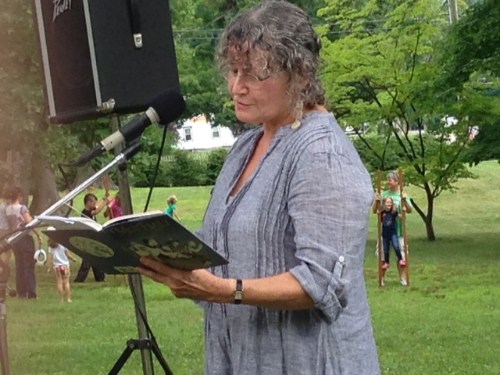
Do you have a favorite Dickinson poem?
I have many favorite Dickinson poems. Here are a few that are at the top of the list:
We never know how high we are
Till we are asked to rise
And then if we are true to plan
Our statures touch the skies –
The Heroism we recite
Would be a normal thing
Did not ourselves the Cubits warp
For fear to be a King –
and
In the name of the Bee –
And of the Butterfly –
And of the Breeze – Amen!
* * *
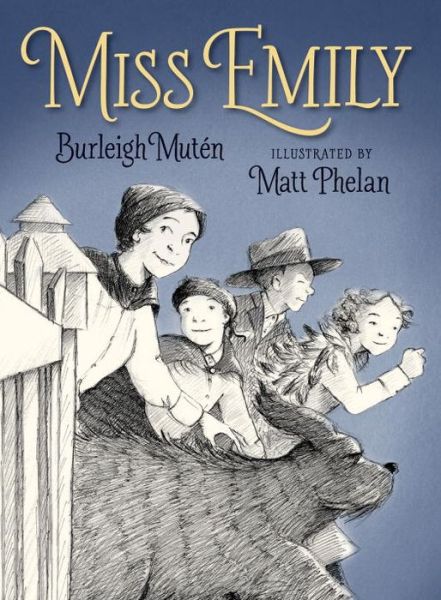
MISS EMILY
written by Burleigh Mutén
illustrated by Matt Phelan
published by Candlewick Press, 2014
Novel in Verse for ages 7+, 144 pp.
*Includes Historical Notes and Bibliography
* * *
♥ ENCORE ♥
- Burleigh Mutén’s Official Website
- Sample Chapter, Author Notes, Teacher’s Guide and more at the publisher’s website
- Emily Dickinson Museum
- More of Matt Phelan’s illustrations and sketches at 7-Imp
- Guest Posts by Burleigh at Write All the Words! and Kidlit Celebrates Women’s History Month
- Lovely words about Burleigh and Miss Emily at Views from a Window Seat
- Review by Jeannine Atkins at Caroline Starr Rose’s blog
* * *
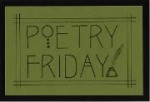 The always warm and gracious Irene Latham is hosting this week’s Roundup at Live Your Poem. Sashay on over and sample some of the many poetic delights on today’s menu. Have a nice weekend!
The always warm and gracious Irene Latham is hosting this week’s Roundup at Live Your Poem. Sashay on over and sample some of the many poetic delights on today’s menu. Have a nice weekend!
———————————-
*MISS EMILY. Text copyright © 2014 by Burleigh Mutén. Illustrations copyright © 2014 by Matt Phelan. Reproduced by permission of the publisher, Candlewick Press, Somerville, MA.
Copyright © 2014 Jama Rattigan of Jama’s Alphabet Soup. All rights reserved.

I am in love with the illustrations in this book… can’t wait to read for myself! I visited Dickinson’s home & museum a couple of years ago and am trying to imagine that scene of the circus parade in Amherst. Thank you for both for sharing! xo
LikeLiked by 1 person
I’m sure you’ll enjoy this wonderful book, Irene. I’d love to return to Amherst and visit Emily’s house sometime. 🙂
LikeLiked by 1 person
I read this wonderful book earlier this year, and loved it. For adults, it’s another wonderful look at Emily Dickinson, but for children, it’s an adventure they will love hearing about. Too often children today are off to school and lessons, with little time for play as the story tells so beautifully. When my children were young, we were able to go to the train yards here in Denver and watch the circus train arrive, just as Burleigh Muten describes, another reason I was so interested in reading the book. It was a magical experience. Thanks for sharing so much about the book and about Burleigh’s journey, Jama.
LikeLike
How wonderful that you used to take your children to watch the circus train arrive! You’re right — this book has interest and appeal for adult as well as kid readers. I love Emily’s sense of adventure and mischief!
LikeLike
Oh, lovely! I want this book.
LikeLiked by 1 person
You will definitely enjoy it, Kate!
LikeLike
Such a great book – excited to have a resource geared towards children to use with Emily Dickinson, who has always been a part of our poetry unit in third grade.
Also love the tidbit about the circus and circus train. Growing up near Milwaukee, watching the Circus Train arrive is one of my strongest childhood memories!
LikeLike
Another person who used to watch the circus train! Lucky you! Nothing like that ever happened in Hawai’i . . .
LikeLike
Thank you for introducing me to this book and author. I will be looking for it.
LikeLike
Yes, do look for it, and enjoy!
LikeLike
Ooh, what a treat!
LikeLike
Charming through and through.
LikeLike
Thanks for introducing Miss Emily–definitely a book I’m going to look for!
LikeLike
Yes, a must read for all Emily fans especially. 🙂
LikeLike
I also loved this book, and learning more about Emily Dickinson and her abiding love for children. I felt that love, her humility, and her joy in the simple things that they could share together. Matt Phelan is masterful at presenting the warmth and peace of the telling. Bravo!
LikeLike
The “joy in the simple things” is what so many of us forget to appreciate once we “grow up.” I think it best to follow Emily’s advice. 🙂
LikeLike
Yeah – another book I can REALLY look forward to reading! Thanks, Jama!
LikeLike
It’s a gem and a complete pleasure to read, Julie. 🙂
LikeLiked by 1 person
So much to make me smile here! Jama, Burleigh, Miss Emily, all these great words and pictures. I will come back to smile again. And Jama, you should come back to Amherst and we can have tea and cake with Burleigh.
LikeLike
Glad you enjoyed the post and that it made you smile, Jeannine. 🙂 I recall driving through Amherst ages ago but don’t remember actually going into the Homestead. Tea and cake definitely sound tempting!
LikeLike
Emily and Burleigh both sound like delightful company. I like the favorite poems that Burleigh shares.
LikeLike
I agree. Those poems are such gems.
LikeLike
I hadn’t heard of this verse novel, but now I want it! Thank you for sharing it today!
LikeLike
Thanks for reading the interview. You will enjoy the book!
LikeLike
I’ve had this on my RADAR and MUST get soon. Swoon. What a treat all around – thank you both for sharing. (And Matt Phelan’s illustrations do look perfect for this book!)
Also, belated Happy Blog Birthday! Please give Mr. Cornelius a special hug from me! :0)
LikeLike
Mr. Cornelius and I send our very best get well wishes. Thanks for commenting even though it must be uncomfortable with your shoulder.
LikeLike
I loved reading Burleigh’s book, and sharing it with my students – but your marvelous interview sheds new light on Dickinson and her times. Love the peek at Burleigh’s office, too – a place of serious work!
LikeLike
Great to hear you’ve already shared it with your students!
LikeLike
This interview is a gem. I loved learning about this side of Emily. Burleigh’s book is on my list, and now I really want to visit the museum – put off for too long! Thank you!
LikeLike
Amherst sounds like a magical place! I want to visit the museum too — even more since I’ve read Burleigh’s book. 🙂
LikeLike
Wow! I must put this book on hold at the library – looking forward to reading it! Thanks, Jama!
LikeLike
I envy your reading it for the first time, Bridget. Enjoy!
LikeLike
What a wonderful post, as always, dearest Jama. I’ve done reviews of two picturebook biographies on Emily, and I missed out on this verse novel. Will definitely check it out from our lirbary. Loved hearing more about Burleigh and her thoughts about poetry. Matt Phelan’s art is just gorgeous.
LikeLike
I love the Emily PBs that are out too. Haven’t seen the one about her dog Carlo, though. Next on my list.
LikeLike
This is a wonderful book! 🙂
LikeLiked by 1 person
YES! 🙂
LikeLike
Thanks to all previous folks who’ve commented on the interview. Writing MISS EMILY was such an enjoyable project. It got me totally hooked on Dickinson and teaching about her to youngsters.
I’m so fortunate to live in Amherst.
LikeLike
Thanks again for everything, Burleigh! You are the best :)!
LikeLike
It’s on my list! I’m happy to see someone else is drawn to Dickinson’s poems about bees. My favorite is:
To make a prairie it takes a clover and one bee,–
One clover, and a bee,
And revery.
The revery alone will do
If bees are few.
LikeLike
Love that bee poem, Diane!
LikeLike
What fun! I love hearing the story behind the story — her process, her research, her lightbulb moments. Thanks for bringing us the double treat of the poet and the novel! Wait, triple, with all the photos. 🙂
LikeLike
This sounds like a lovely story- and the art is beautiful! Thanks!
LikeLike
Thanks for stopping by to read, Iza!
LikeLike
Fabulous interview! Now I have another book to add to my wish list. Thank you.
LikeLike